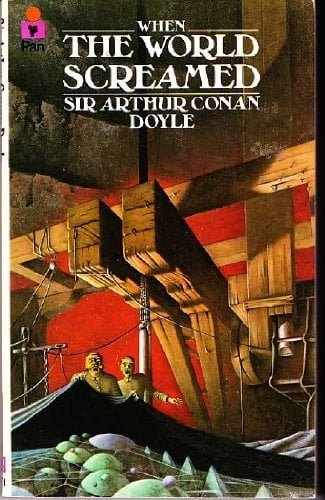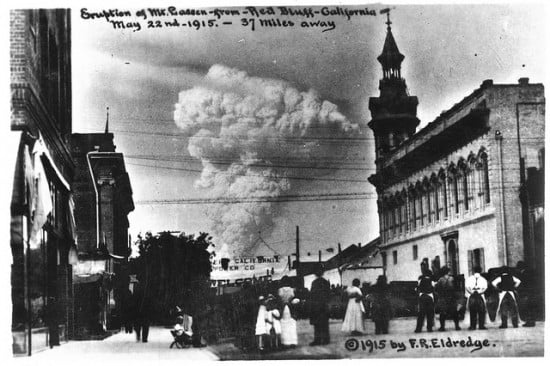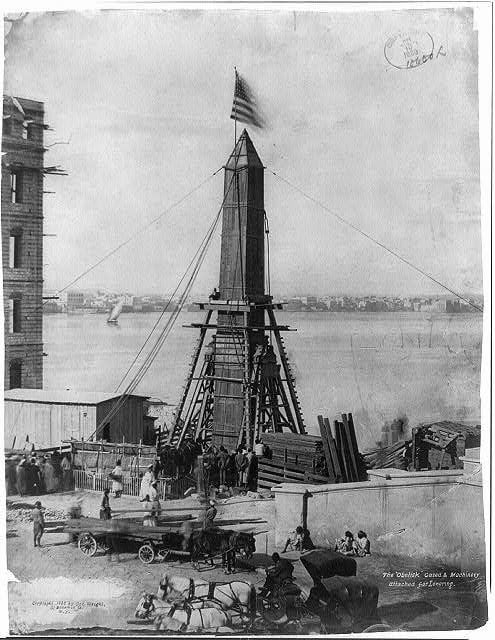When the World Screamed (11)
By:
November 24, 2015

Arthur Conan Doyle’s novella When the World Screamed was first published in 1928. The fifth and final Professor Challenger adventure, it takes us not outward (e.g., to a South American plateau crawling with dinosaurs), nor inward (e.g., to an airtight chamber, while the Earth passes through a poison belt), but instead downward. Challenger, here described as “a primitive cave-man in a lounge suit,” while also “the greatest brain in Europe,” proposes to drill his way from a tract of land in Sussex (England) eight miles beneath the planet’s epidermis. Why? In order to prove his hypothesis that the world is itself a living organism! Enjoy.
Then came the geyser. It was an enormous spout of vile treacly substance of the consistence of tar, which shot up into the air to a height which has been computed at two thousand feet. An inquisitive aeroplane, which had been hovering over the scene, was picked off as by an Archie and made a forced landing, man and machine buried in filth. This horrible stuff, which had a most penetrating and nauseous odour, may have represented the life blood of the planet, or it may be, as Professor Driesinger and the Berlin School maintain, that it is a protective secretion, analogous to that of the skunk, which Nature has provided in order to defend Mother Earth from intrusive Challengers. If that were so the prime offender, seated on his throne upon the hillock, escaped untarnished, while the unfortunate Press were so soaked and saturated, being in the direct line of fire, that none of them was capable of entering decent society for many weeks.

This gush of putridity was blown southwards by the breeze, and descended upon the unhappy crowd who had waited so long and so patiently upon the crest of the Downs to see what would happen. There were no casualties. No home was left desolate, but many were made odoriferous, and still carry within their walls some souvenir of that great occasion.
And then came the closing of the pit. As Nature slowly closes a wound from below upwards, so does the Earth with extreme rapidity mend any rent which is made in its vital substance. There was a prolonged high-pitched crash as the sides of the shaft came together, the sound, reverberating from the depths and then rising higher and higher until with a deafening bang the brick circle at the orifice flattened out and clashed together, while a tremor like a small earthquake shook down the spoil banks and piled a pyramid fifty feet high of debris and broken iron over the spot where the hole had been. Professor Challenger’s experiment was not only finished, it was buried from human sight for ever. If it were not for the obelisk which has now been erected by the Royal Society it is doubtful if our descendants would ever know the exact site of that remarkable occurrence.

And then came the grand finale. For a long period after these successive phenomena there was a hush and a tense stillness as folk reassembled their wits and tried to realize exactly what had occurred and how it had come about. And then suddenly the mighty achievement, the huge sweep of the conception, the genius and wonder of the execution, broke upon their minds. With one impulse they turned upon Challenger. From every part of the field there came the cries of admiration, and from his hillock he could look down upon the lake of upturned faces broken only by the rise and fall of the waving handkerchiefs. As I look back I see him best as I saw him then. He rose from his chair, his eyes half closed, a smile of conscious merit upon his face, his left hand upon his hip, his right buried in the breast of his frock-coat. Surely that picture will be fixed for ever, for I heard the cameras clicking round me like crickets in a field.
The June sun shone golden upon him as he turned gravely bowing to each quarter of the compass. Challenger the super scientist, Challenger the arch-pioneer, Challenger the first man of all men whom Mother Earth had been compelled to recognize.
Only a word by way of epilogue. It is of course well known that the effect of the experiment was a world-wide one. It is true that nowhere did the injured planet emit such a howl as at the actual point of penetration, but she showed that she was indeed one entity by her conduct elsewhere. Through every vent and every volcano she voiced her indignation. Hecla bellowed until the Icelanders feared a cataclysm. Vesuvius blew its head off. Etna spewed up a quantity of lava, and a suit of half-a-million lira damages has been decided against Challenger in the Italian Courts for the destruction of vineyards. Even in Mexico and in the belt of Central America there were signs of intense Plutonic indignation, and the howls of Stromboli filled the whole Eastern Mediterranean. It has been the common ambition of mankind to set the whole world talking. To set the whole world screaming was the privilege of Challenger alone.
RADIUM AGE SCIENCE FICTION: “Radium Age” is HILOBROW’s name for the 1904–33 era, which saw the discovery of radioactivity, the revelation that matter itself is constantly in movement — a fitting metaphor for the first decades of the 20th century, during which old scientific, religious, political, and social certainties were shattered. This era also saw the publication of genre-shattering writing by Edgar Rice Burroughs, Sax Rohmer, E.E. “Doc” Smith, Jack London, Arthur Conan Doyle, Aldous Huxley, Olaf Stapledon, Karel Čapek, H.P. Lovecraft, Charlotte Perkins Gilman, Yevgeny Zamyatin, Philip Gordon Wylie, and other pioneers of post-Verne/Wells, pre-Golden Age “science fiction.” More info here.
READ GORGEOUS PAPERBACKS: HiLoBooks has reissued the following 10 obscure but amazing Radium Age science fiction novels in beautiful print editions: Jack London’s The Scarlet Plague, Rudyard Kipling’s With the Night Mail (and “As Easy as A.B.C.”), Arthur Conan Doyle’s The Poison Belt, H. Rider Haggard’s When the World Shook, Edward Shanks’ The People of the Ruins, William Hope Hodgson’s The Night Land, J.D. Beresford’s Goslings, E.V. Odle’s The Clockwork Man, Cicely Hamilton’s Theodore Savage, and Muriel Jaeger’s The Man with Six Senses. For more information, visit the HiLoBooks homepage.
SERIALIZED BY HILOBOOKS: Jack London’s The Scarlet Plague | Rudyard Kipling’s With the Night Mail (and “As Easy as A.B.C.”) | Arthur Conan Doyle’s The Poison Belt | H. Rider Haggard’s When the World Shook | Edward Shanks’ The People of the Ruins | William Hope Hodgson’s The Night Land | J.D. Beresford’s Goslings | E.V. Odle’s The Clockwork Man | Cicely Hamilton’s Theodore Savage | Muriel Jaeger’s The Man With Six Senses | Jack London’s “The Red One” | Philip Francis Nowlan’s Armageddon 2419 A.D. | Homer Eon Flint’s The Devolutionist | W.E.B. DuBois’s “The Comet” | Edgar Rice Burroughs’s The Moon Men | Charlotte Perkins Gilman’s Herland | Sax Rohmer’s “The Zayat Kiss” | Eimar O’Duffy’s King Goshawk and the Birds | Frances Hodgson Burnett’s The Lost Prince | Morley Roberts’s The Fugitives | Helen MacInnes’s The Unconquerable | Geoffrey Household’s Watcher in the Shadows | William Haggard’s The High Wire | Hammond Innes’s Air Bridge | James Branch Cabell’s Jurgen | John Buchan’s “No Man’s Land” | John Russell’s “The Fourth Man” | E.M. Forster’s “The Machine Stops” | John Buchan’s Huntingtower | Arthur Conan Doyle’s When the World Screamed | Victor Bridges’ A Rogue By Compulsion | Jack London’s The Iron Heel | H. De Vere Stacpoole’s The Man Who Lost Himself | P.G. Wodehouse’s Leave It to Psmith | Richard Connell’s “The Most Dangerous Game” | Houdini and Lovecraft’s “Imprisoned with the Pharaohs” | Arthur Conan Doyle’s “The Sussex Vampire.”
